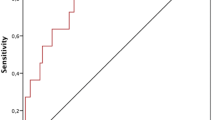Abstract
Objective
This cross-sectional study was designed to assess the clinical significance of the serum KL-6 in the diagnosis of interstitial lung disease (ILD) in patients with idiopathic inflammatory myopathy (IIM).
Methods
We measured serum KL-6 levels in 184 patients with IIM using a chemiluminescent enzyme immunoassay and compared KL-6 levels between patients with and without ILD, according to other clinical features.
Results
IIM patients with ILD had significantly higher serum KL-6 levels than those without ILD (776.5 [372.3–1378.8] vs. 297.5 [204.75–599.3] U/ml, P < 0.001). At a cut-off of 461.5 U/ml identified by ROC curve, serum KL-6 yielded a sensitivity of 70.2% and specificity of 73.9% for ILD in IIM patients. IIM patients with an elevated serum KL-6 were more likely to have clinical symptoms of mechanic’s hands (P = 0.002), anti-Jo-1 antibody positivity (P = 0.021), dysphagia (P = 0.039), hoarseness (P < 0.001), and polyarthritis/polyarthralgia (P < 0.001). Significant inverse correlations were found between serum KL-6 levels and pulmonary function tests (P < 0.01), including forced vital capacity (FVC, %Pred), total lung capacity (TLC, %Pred), and diffusing capacity for carbon monoxide (DLCO, %Pred).
Conclusions
Serum KL-6 offers high sensitivity and specificity for the diagnosis of IIM-associated ILD and is inversely correlated with pulmonary function deterioration. Serum KL-6 may represent a promising biomarker for monitoring ILD severity in IIM patients.




Similar content being viewed by others
References
Rider LG, Miller FW (2011) Deciphering the clinical presentations, pathogenesis, and treatment of the idiopathic inflammatory myopathies. JAMA 305:183–190
Dalakas MC, Hohlfeld R (2003) Polymyositis and dermatomyositis. Lancet 362:971–982
Hallowell RW, Ascherman DP, Danoff SK (2014) Pulmonary manifestations of polymyositis/dermatomyositis. Semin Respir Crit Care Med 35:239–248
Labirua A, Lundberg IE (2010) Interstitial lung disease and idiopathic inflammatory myopathies: progress and pitfalls. Curr Opin Rheumatol 22:633–638
Kohno N, Kyoizumi S, Awaya Y, Fukuhara H, Yamakido M, Akiyama M (1989) New serum indicator of interstitial pneumonitis activity. Sialylated carbohydrate antigen KL-6. Chest 96:68–73
Bonella F, Volpe A, Caramaschi P et al (2011) Surfactant protein D and KL-6 serum levels in systemic sclerosis: correlation with lung and systemic involvement. Sarcoidosis Vasc Diffuse Lung Dis 28:27–33
Yanaba K, Hasegawa M, Takehara K, Sato S (2004) Comparative study of serum surfactant protein-D and KL-6 concentrations in patients with systemic sclerosis as markers for monitoring the activity of pulmonary fibrosis. J Rheumatol 31:1112–1120
Vesely R, Vargova V, Ravelli A et al (2004) Serum level of KL-6 as a marker of interstitial lung disease in patients with juvenile systemic sclerosis. J Rheumatol 31:795–800
Kumanovics G, Gorbe E, Minier T, Simon D, Berki T, Czirjak L (2014) Follow-up of serum KL-6 lung fibrosis biomarker levels in 173 patients with systemic sclerosis. Clin Exp Rheumatol 32:S–138-144
Bandoh S, Fujita J, Ohtsuki Y, Ueda Y, Hojo S, Tokuda M, Dobashi H, Kurata N, Yoshinouchi T, Kohno N, Takahara J (2000) Sequential changes of KL-6 in sera of patients with interstitial pneumonia associated with polymyositis/dermatomyositis. Ann Rheum Dis 59:257–262
Bohan A, Peter JB (1975) Polymyositis and dermatomyositis (first of two parts). N Engl J Med 292:344–347
Bohan A, Peter JB (1975) Polymyositis and dermatomyositis (second of two parts). N Engl J Med 292:403–407
Zhang L, Wu G, Gao D, Liu G, Pan L, Ni L, Li Z, Wang Q (2016) Factors associated with interstitial lung disease in patients with polymyositis and dermatomyositis: a systematic review and meta-analysis. PLoS One 11:e0155381
Fathi M, Barbasso Helmers S, Lundberg IE (2012) KL-6: a serological biomarker for interstitial lung disease in patients with polymyositis and dermatomyositis. J Intern Med 271:589–597
Wang Y, Chen S, Lin Z, du G, Lin J, Lin Q, Xiufeng H, Zhang G, Furst DE, Gargani L, Matucci-Cerinic M (2018) Imaging and serum biomarkers in connective tissue disease-associated interstitial lung diseases: correlation between lung ultrasound B-lines and KL-6 levels. Ann Rheum Dis:annrheumdis-2018-214098
Salazar GA, Kuwana M, Wu M, Estrada-Y-Martin RM, Ying J, Charles J, Mayes MD, Assassi S (2018) KL-6 but not CCL-18 is a predictor of early progression in systemic sclerosis-related interstitial lung disease. J Rheumatol 45:1153–1158
Benyamine A, Heim X, Resseguier N, Bertin D, Gomez C, Ebbo M, Harlé JR, Kaplanski G, Rossi P, Bardin N, Granel B (2018) Elevated serum Krebs von den Lungen-6 in systemic sclerosis: a marker of lung fibrosis and severity of the disease. Rheumatol Int 38:813–819
Hallowell RW, Danoff SK (2014) Interstitial lung disease associated with the idiopathic inflammatory myopathies and the antisynthetase syndrome: recent advances. Curr Opin Rheumatol 26:684–689
Marie I, Josse S, Decaux O, Dominique S, Diot E, Landron C, Roblot P, Jouneau S, Hatron PY, Tiev KP, Vittecoq O, Noel D, Mouthon L, Menard JF, Jouen F (2012) Comparison of long-term outcome between anti-Jo1- and anti-PL7/PL12 positive patients with antisynthetase syndrome. Autoimmun Rev 11:739–745
Oguz EO, Kucuksahin O, Turgay M, Yildizgoren MT, Ates A, Demir N, Kumbasar OO, Kinikli G, Duzgun N (2016) Association of serum KL-6 levels with interstitial lung disease in patients with connective tissue disease: a cross-sectional study. Clin Rheumatol 35:663–666
Funding
This study was supported by the National Natural Science Foundation of China (81771780, 81471615, 81102268, 81302610), the Outstanding Youth Fund of Peking Union Medical College Hospital (JQ201504), the CAMS Initiative for Innovative Medicine (2017-I2M-3-001), and the 2016 PUMCH Science Fund for Junior faculty (pumch-2016-1.5).
Author information
Authors and Affiliations
Corresponding authors
Ethics declarations
This study was approved by the Medical Ethics Committee of Peking Union Medical College Hospital (S-478). The methods were carried out in accordance with the principles stated in the Declaration of Helsinki, and informed consent was obtained from each patient.
Disclosures
None.
Additional information
Publisher’s note
Springer Nature remains neutral with regard to jurisdictional claims in published maps and institutional affiliations.
Rights and permissions
About this article
Cite this article
Hu, C., Wu, C., Yang, E. et al. Serum KL-6 is associated with the severity of interstitial lung disease in Chinese patients with polymyositis and dermatomyositis. Clin Rheumatol 38, 2181–2187 (2019). https://doi.org/10.1007/s10067-019-04501-9
Received:
Revised:
Accepted:
Published:
Issue Date:
DOI: https://doi.org/10.1007/s10067-019-04501-9




